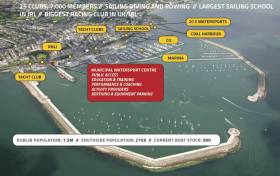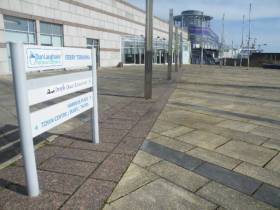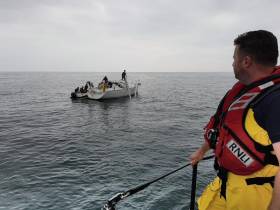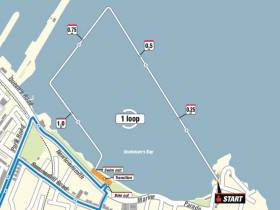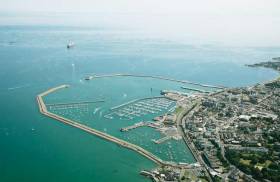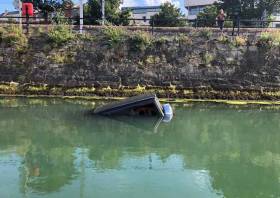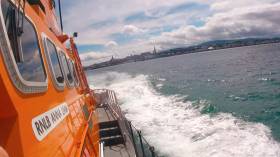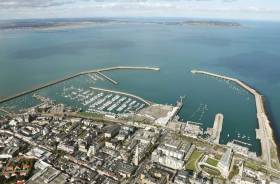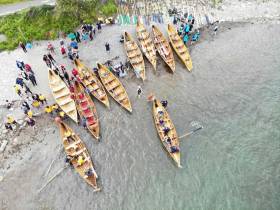Displaying items by tag: Dun Laoghaire
Plastic fibres released during construction on the Dun Laoghaire baths site last year have again washed up on nearby beaches, as The Irish Times reports.
The plastic shards were washed into the water during a concrete pour at the development last November, prompting a safety advisory for swimmers and beach-goers between the West Pier and the Forty Foot.
A clean-up operation was launched at the time which recovered 50kg of the 70kg of plastic strands released.
Now a volunteer clean-up group says some of the unrecovered plastic reappeared at Sandycove on Thursday ahead of Storm Lorenzo.
The Irish Times has more on the story HERE.
Dun Laoghaire Town & Its Harbour Users: Must it Be a Continuing State of Mutual Incomprehension?
Mark Twain used to say that you should never get into a row with anyone who buys ink by the barrel. But last weekend The Irish Times, our national Paper of Record, ran a Weekend Review feature about the problematical relationship of Dun Laoghaire with its harbour, a two-article feature which concentrated largely on the town’s urban blight of shuttered shops and commercial dereliction at its centre, while giving only scant attention to the waterfront and the harbour, with their problems and potentials for development and better interaction with the town.
It all initially sounded well-meaning and timely, in view of the fact that the 17th September is the closing date for €200,000 worth of contracts – two of them – for tenders for surveys providing expert economic and strategic advice about how the blighted parts of the town might be revived, and how the harbour might be more usefully developed.
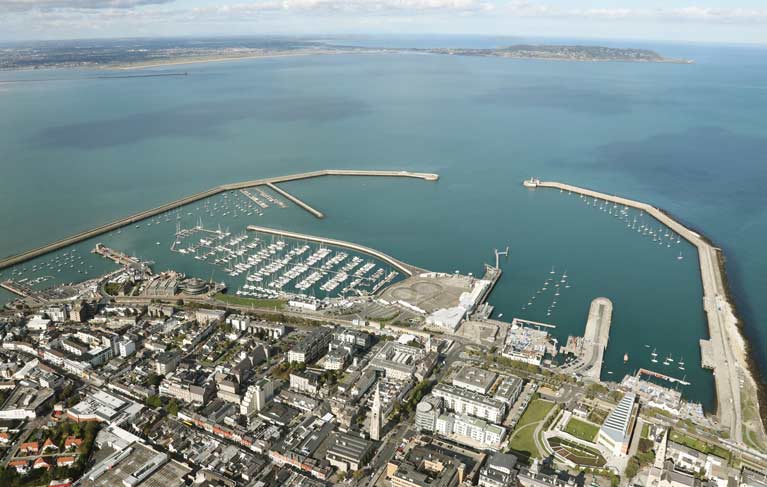 A town and its harbour – in Dun Laoghaire, inter-community attitudes are shaped by many other elements in addition to the fact that road and railway create a physical divide for part of the waterfront. Photo Barrow Coakley/Simon Coate
A town and its harbour – in Dun Laoghaire, inter-community attitudes are shaped by many other elements in addition to the fact that road and railway create a physical divide for part of the waterfront. Photo Barrow Coakley/Simon Coate
Dun Laoghaire Rathdown Council took over control of the harbour only as recently as late last year, so it will take time for an attitude of joined-up thinking regarding the relationship of town and harbour to develop properly. As it is, the very framing of these tenders shows that the attitude of seeing town and harbour as separate entities still persists, as one set of expert advice is sought for the regeneration of “Dun Laoghaire’s town centre adjacent to the harbour”, while the other is one is “seeking expert advice for the development of the harbour for the benefit of its citizens”.
But however they go about it, the situation is a matter of some urgency, as they’re immediately faced with a major problem. Since the Dun Laoghaire ferry port ceased functioning in 2015, the harbour has an increasingly significant deficit in its maintenance budget.
It’s a serious situation, involving everyone. In view of that, somebody has to say that The Irish Times feature was a travesty of what such an overview should be. While a succession of traders and politicians in the town were interviewed about its problems of urban blight, and the problems of its high-maintenance harbour, not one interview was conducted with anyone who is active in any way around the harbour, whether as a marine trader or sailor or boat or watersports enthusiast in any form whatsoever.
Yet it was a research mission and ensuing feature which seemed at first to merit serious attention. The articles - given considerable prominence - were by two of the paper’s most distinguished contributors: journalist Jennifer O’Connell and economist David McWilliams. It must have been given some thought. But even on ploughing through it a second time, we still couldn’t find any suggestion that either had talked to anyone other than local business people or politicians. There wasn’t so much as the tiniest cheep - neither from the Dun Laoghaire boating and sailing community nor from the businesses which specifically serve their needs - about what their hopes for harbour and waterfront development and relationships with the town might be.
David McWilliams now has skin in the game. As anyone who reads his usually stimulating columns will be aware, having for some time been a pillar of Dalkey intellectual society, he and his family have recently moved to a substantial waterfront house beside Dun Laoghaire harbour. So he must see some future in the place. And who knows, but maybe some time he might take an active interest in boats beyond seeing them as some sort of ornaments which help to remind him that he is in the desirable position of living beside the sea.
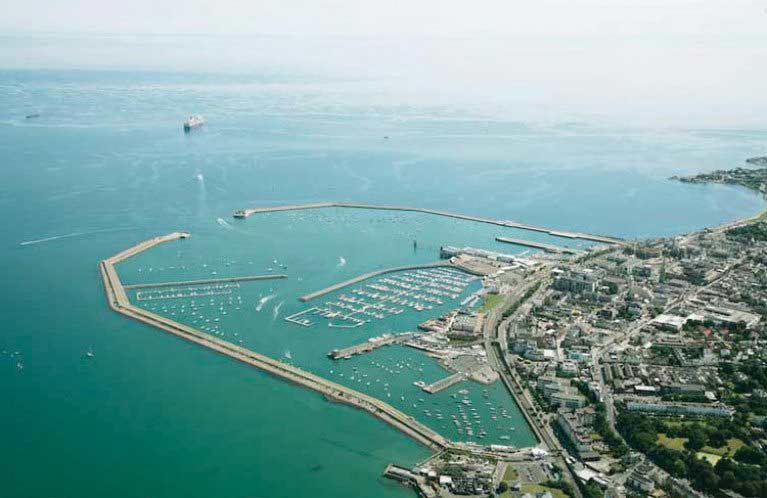 Summer in Dun Laoghaire – in such a setting, harmony between land and sea should come naturally. Photo Peter Barrow
Summer in Dun Laoghaire – in such a setting, harmony between land and sea should come naturally. Photo Peter Barrow
As for Jennifer O’Connell, she seems to live somewhere beyond The Pale, but in terms of working as an Irish Times columnist and reporter, she makes the Duracell Bunny look like a complete and utter layabout, with her lengthy article on Dun Laoghaire making our usual Sailing on Saturday long-form story look like a quick post-it message.
But even she – in her long and detailed piece – has managed to avoid the boat folk. Now admittedly in her sprint through a couple of those sadder Dun Laoghaire shopping streets that you find as you move inland from the increasingly chic waterfront, she did chat with Australian sailor Bruce Du Ve, who has settled in Dun Laoghaire, and some of you will know him. But it emerged that the reason for the interview is because Bruce is running an acupuncture clinic in Dun Laoghaire, and thus is seen as a representative local businessman.
The nearest he was allowed to talk about sailing was in making the point that when a breeze blows through Dun Laoghaire’s granite-hard streets, regardless of its suitability or otherwise for sailing such a breeze inevitably seems to carry an indecent amount of litter with it, and Bruce wonders why it is so difficult to clean the streets. Reasonable enough, perhaps. But what Bruce thinks about sailing in Dun Laoghaire is left as a matter for speculation.
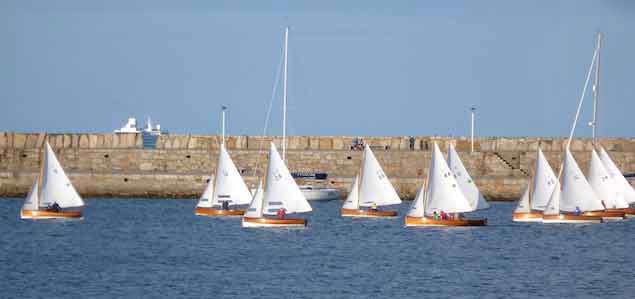 The Water Wags have been racing in Dun Laoghaire since 1887, with the present class dating to 1900. The magnificently-built 200-year-old granite harbour seems so much a part of the seascape and the land beside it that the locals tend to see it as a natural feature of Dublin Bay. Photo: W M Nixon
The Water Wags have been racing in Dun Laoghaire since 1887, with the present class dating to 1900. The magnificently-built 200-year-old granite harbour seems so much a part of the seascape and the land beside it that the locals tend to see it as a natural feature of Dublin Bay. Photo: W M Nixon
Maybe that’s a very subtle technique of High Journalism for keeping us interested. Whatever, we’ve been here before on the conundrum of the Dun Laoghaire and its harbour situation, and God knows, we’ll be here again. But its approaching wave of new attention thanks to that tendering date of just ten days hence brings it top of the bill right now.
Thus for journalists and others seriously hoping to find out how Dun Laoghaire is currently inter-acting positively with the sea and sailing and boating, a logical first stop would be a discussion with Kenneth Rumball of the Irish National Sailing and Powerboat School, which is located in a hyper-busy little building on the quayside in the somewhat hidden southwest corner of the Inner Harbour. Size-for-size since its establishment by Kenneth’s father Alistair in 1974, the INSS has done more to introduce complete newcomers to sailing and boating in Ireland than any other comparable organisation.
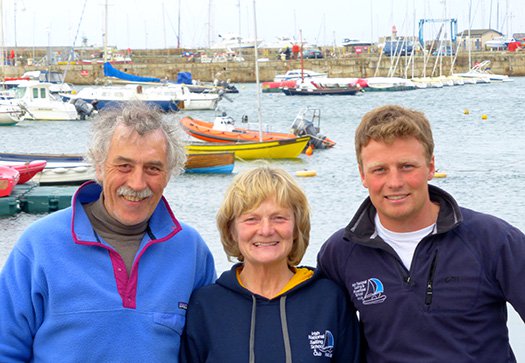 Alistair Rumball (left) founder in 1974 of the Irish National Sailing School in Dun Laoghaire, with his wife Muriel and son Kenneth, current School Director. Photo: W M Nixon
Alistair Rumball (left) founder in 1974 of the Irish National Sailing School in Dun Laoghaire, with his wife Muriel and son Kenneth, current School Director. Photo: W M Nixon
The figures run into the tens of thousands and have included crews who have been taken right to the top for competition in both the Round Ireland and Fastnet Races, in both of which the INSS boat has won her class.
As for the school, while it is of course a private enterprise business extremely efficiently run, it is almost like a classic mutual society company in many ways, and within its setup is a proper sailing club, complete with committee and flag officers, such that those who start from scratch as beginner sailors with the INSS can go all the way to recognised sailing competition at local, national and international level, all under the INSS umbrella.
Thus the breadth and depth of experience at the INSS about what people new to sailing expect from Dun Laoghaire Harbour now and in the future is unrivalled. Yet did either of the journalists creating The Irish Times feature of a week ago contact Kenneth Rumball or one of his colleagues? No, they did not.
At a different level of interaction with the sailing community of Dun Laoghaire is the marine store of Viking Marine in Marine Road, plumb in the middle of the relatively new Pavilion Development. Viking Marine reflects the growing vitality and style of Dun Laoghaire’s classic waterfront as the years of the harbour being a ferryport recede into history.
Admittedly Dun Laoghaire ferryport was never a seriously unpleasant place like Dover, or the scruffily spread-out ferryport area that we find in Holyhead. But even so, the regular throughput of shiploads of cars and trucks was detrimental to the style and atmosphere of the waterfront, and now that the heavy trucks are no longer blighting the narrow roads, the area is being re-born.
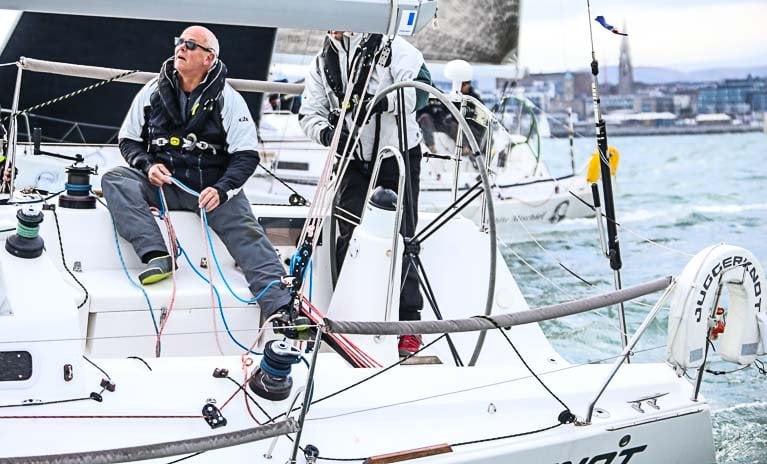 Work or play? Ian O’Meara of Viking Marine in Dun Laoghaire at his favourite sport off his favourite town. Photo Afloat.ie/David O’Brien
Work or play? Ian O’Meara of Viking Marine in Dun Laoghaire at his favourite sport off his favourite town. Photo Afloat.ie/David O’Brien
Consequently Viking Marine is at the very heart of what Dun Laoghaire’s future might be. But did The Irish Times make any contact whatever with Ian O’Meara, Managing Director of Viking Marine. No, they did not.
Yet with Ian O’Meara they would have found in one notably savvy person a very complete and thoughtful projection of how the relationship of Dun Laoghaire and its harbour could usefully be developed. Not only does he run one of the most successful shops in the town, but he’s an active sailor himself, very much part of the front-line sailing community - so much so, in fact, that he was a key crewmember on the winning boat in 2019’s biennial staging of the rugged Dun Laoghaire to Dingle Race.
But despite Ian O’Meara’s very special position in the centre of the marine leisure retail/customer dynamic in Dun Laoghaire, The Irish Times didn’t see fit to draw on his unique knowledge and experience. Nor did they chat with Paal Janson, manager of the extensive and award-winning Dun Laoghaire Marina.
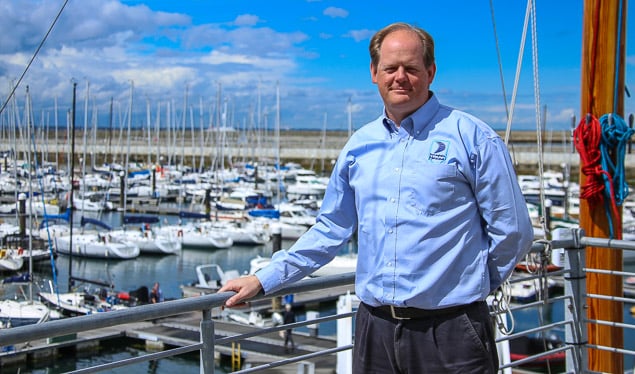 Paal Janson of Dun Laoghaire Marina. Photo: Afloat.ie/David O’Brien
Paal Janson of Dun Laoghaire Marina. Photo: Afloat.ie/David O’Brien
No contact seems to have been made either with any of the four waterfront yacht clubs, despite the fact that they make an exemplary job of utilizing and running their very limited spaces while providing the sailing and training programmes which give Dun Laoghaire Harbour its favourable international image, even if parts of the town behind it seeming to be unable to keep up with the new pace and style. And even Irish Sailing, the National Authority which is headquartered in Dun Laoghaire, seems to have been unaware that The Irish Times were in town on this research project.
So why has Dun Laoghaire town never really interacted comfortably in modern times with its massive 200 years old harbour, which is such a magnificent piece of granite construction that most folk think of it as a natural feature, whereas it is just about artificial as it can get – its brilliant use of granite simply deludes us.
It was never built to be a port. It was built as a harbour of shelter primarily to meet the needs of the ships of British imperial power. Thus there is a totally inadequate landward space to serve the needs of a port in the trading and commercial sense. And though the use of it as a ferryport worked fine in the great days of rail travel when Carlisle Pier – a railway station and ship quay on stilts operational from 1859 - was ingeniously inserted in a piece of design brilliance such that it looked to be an integral part of the whole thing, when railways were superseded by road transport, Dun Laoghaire began to become a disaster area.
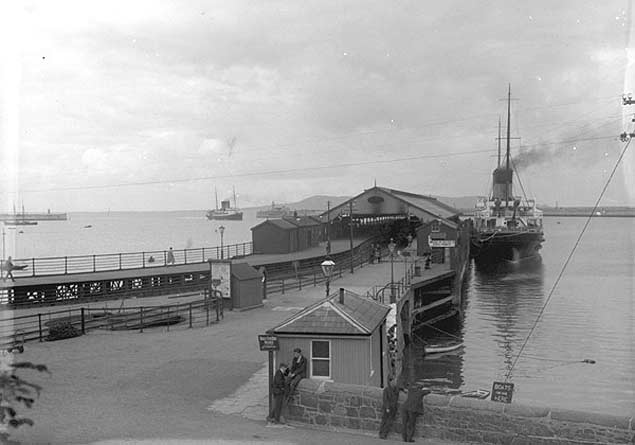 The glory days of Dun Laoghaire as a ferry port, when Victorian engineering ingenuity inserted the Carlisle Pier into the harbour in 1859 as though it had always been there, in order to bring Ireland’s growing railway system into direct contact with the cross-channel ferry service. It was neat and economical of space, with no need for huge car and truck marshalling yards.
The glory days of Dun Laoghaire as a ferry port, when Victorian engineering ingenuity inserted the Carlisle Pier into the harbour in 1859 as though it had always been there, in order to bring Ireland’s growing railway system into direct contact with the cross-channel ferry service. It was neat and economical of space, with no need for huge car and truck marshalling yards.
Cynics may point out that Dun Laoghaire’s years of administrative malfunction roughly coincide with the inauguration of the new Irish state. That’s probably too simplistic, but it is a fact that all efforts to modify the harbour for the accommodation of Ro-Ro ferries have ended with environmental messes which sometimes didn’t even get properly cleared away when their usefulness has ceased.
When Carlisle Pier was irretrievably cut off from the main rail network because rail transport was rapidy declining in the face of road growth while the Dun Laoghaire line itself was becoming a significant part of the new DART commuter system, the pier was gradually reduced in its usefulness. For a while, a now mercifully forgotten Ro-Ro berth was spatch-cocked on to the East Pier just north of the National Yacht Club. In this case, its detritus was cleared away when British rail introduced a new much larger ship which required a real cat’s cradle of ramp facilities right in front of the Royal St George Yacht Club, leading to a ramp attached to the west side of the now-decaying Carlisle Pier.
Then came the advent of the even bigger cross-channel HSS (High Speed Ship). A giant and expensive-to-run object which floated and went fast (you would hardly call it a ship), it provided much entertainment for kids learning sailing in the new Laser class, as they challenged each other to sail under the length of it between the hulls. But whether or not it made money was always a moot point, and it didn’t do to be on the last sailing cross-channel of the day, as they could sometimes run at slow speed to save fuel costs, and you’d invariably arrive late.
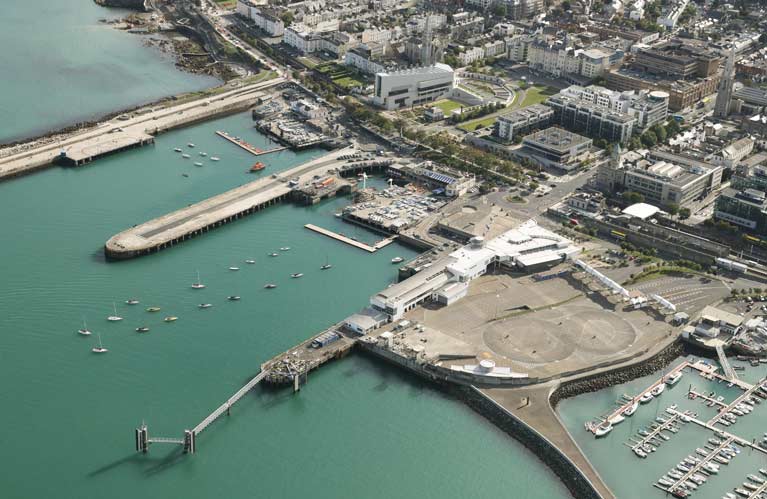 The enormous but unused car marshalling yards and ferry terminal buildings installed at St Michael’s Wharf, with the Royal St George YC and the National YC beyond. At present, it seems that the legal situation regarding the very existence of the St Michael’s Wharf installations may be a matter of debate. Photo Barrow Coakley/Simon Coate
The enormous but unused car marshalling yards and ferry terminal buildings installed at St Michael’s Wharf, with the Royal St George YC and the National YC beyond. At present, it seems that the legal situation regarding the very existence of the St Michael’s Wharf installations may be a matter of debate. Photo Barrow Coakley/Simon Coate
Regardless of that, the Irish authorities had rolled over and collaborated in the building of an enormous terminal complex, complete with huge offices and reception halls and whatever, right in the middle of the Dun Laoghaire waterfront at St Michael’s Wharf, while Carlisle Pier to the southeastward was more or less abandoned.
But, challenged by newer and more nimble ferries operating out of the cost-cutting and rapidly-developing Dublin Port which offered quicker access via the Port Tunnel to the fast-growing Irish motorway system, Dun Laoghaire as a ferryport was commercially doomed. In today’s circumstances, you would need a motorway-standard dual carriageway direct from the St Michael’s Wharf ferry terminal complex to the nearest part of the M50 in order for the Dun Laoghaire route to be successful. It would probably cost as much as the HS2 rail-link looks like costing in England (if the HS2 is ever built), but the Dun Laoghaire Harbour to M50 superlink is definitely a non-starter.
As for the brief flirtation with creating a cruise-liner berth, fortunately that was stopped by community action and an increasing awareness that big cruise liners are a high-pollution snare and a delusion. Most of their passengers don’t bother to go ashore, so the main benefit is only in berthing charges, while the few who do go ashore are on bus tours to the nearest internationally-recognised tourism magnets, with the fees for the buses paid as part of the all-up cruise package back in Minneapolis or Beijing or wherever, so only the bus operators benefit, and not the local traders.
Thus now we have Dun Laoghaire, more popular than ever as a sailing centre of international repute, the lungs of the city for those thousands who are just gasping for a bit of sea air, and an increasingly fashionable place to live on the waterfront as environment-harming commercial transport activity reduces.
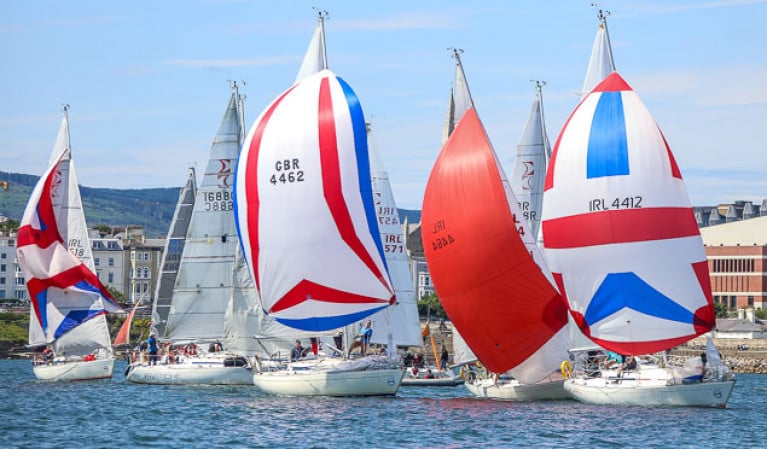 Classic Dun Laoghaire sailing – more popular today than ever. Photo Afloat.ie/David O’Brien
Classic Dun Laoghaire sailing – more popular today than ever. Photo Afloat.ie/David O’Brien
It would seem the most natural thing in the world for town and harbour to move harmoniously together. Yet it is faced with the double problem of how to bring the town behind it up to the level of vitality which the harbour and its waterfront is increasingly manifesting, and how to pay for the maintenance of that harbour which ultimately is the making of the town.
The basic vitality of the harbour manifests itself that despite the fact that, over the years, the authorities officially charged with its administration of it have left behind areas of abandoned dereliction. Looking at the waterfront and its many “units” from seaward provides a clear message which speaks volumes about which sector – public or semi-private - provides the better administration.
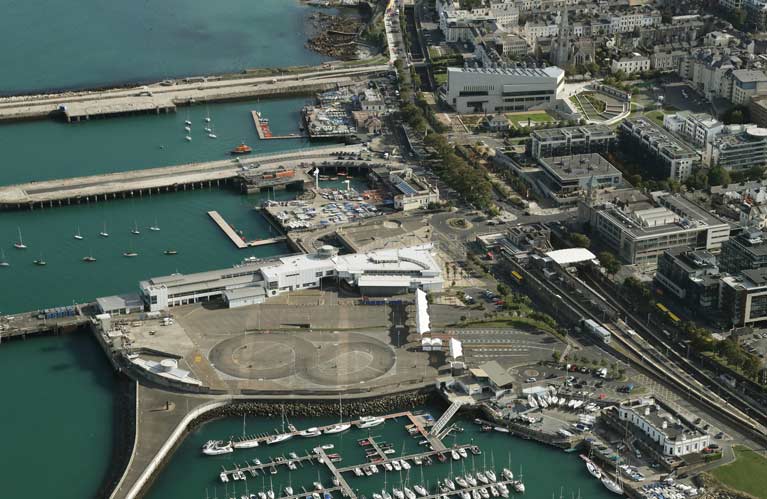 The most visible section of Dun Laoghaire’s waterfront, with the National Yacht Club, the Royal St George Yacht Club, and the Royal Irish Yacht Club very much alive and active, while between them are the “dead” areas of Carlisle Pier and St Michael’s Wharf. Photo: Barrow Coakley/Simon Coate
The most visible section of Dun Laoghaire’s waterfront, with the National Yacht Club, the Royal St George Yacht Club, and the Royal Irish Yacht Club very much alive and active, while between them are the “dead” areas of Carlisle Pier and St Michael’s Wharf. Photo: Barrow Coakley/Simon Coate
The waterfront premises in this category directly interacting with the sea are (going from east to west):
- National Yacht Club: overall voluntary administrators with professional management - very well run.
- RNLI: professionally managed with volunteers – excellent.
- Carlisle Pier: officially managed, a neglected disgrace.
- Royal St George Yacht Club: overall voluntary administraors, professionally managed, very well run.
- St Michael’s Wharf Ferry Terminal: Officially run large unused space with extensive Ferry Terminal Buildings, currently in limbo as official status and existence of Foreshore Licence has not been clarified.
- Dun Laoghaire Marina: Commercial marina with 830 berths, professionally run to an award-winning standard.
- Royal Irish Yacht Club: overall voluntary administrators, professional management, very well run.
- Irish Lights Main Shore Facility and HQ: professionally run National Lights Authority.
- Irish Sailing’s Performance Sailing Base: professionally managed, well run.
- MGM Boats: Boat sales and boatyard services with Travel Hoist: A vital commercial facility which is well run despite being in premises which are limited by the intrusion of some original features of the 200-year-old harbour
- Coal Harbour (aka Inner Harbour): Mainly under official management, limited by presence of features from original harbour and location of under-utilised former Coastguard Building, entire setup too ready to avail of income from car-parking for nearby railway station.
- St Michael’s Rowing Club: Hugely effective voluntary organisation which functions very successfully despite its shoreside premises being in a cave-like space under one of the raised roadways which remain as part of the original harbour.
- Irish National Sailing School: Commercial operation which very effectively introduces hundreds to sailing and boating each year, yet manages to create a club-like atmosphere in rather restricted premises.
- Dun Laoghaire Motor Yacht Club: Friendly voluntarily-run club with some professional input which makes the very best of restricted quayside premises.
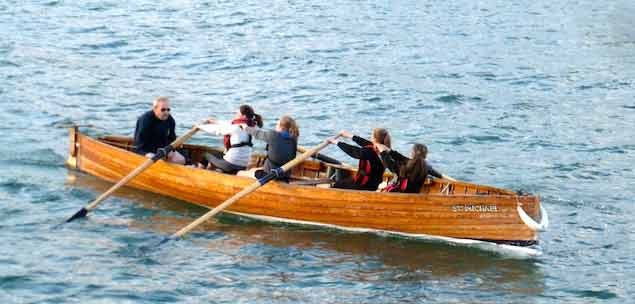 Tough training with one of the coastal rowing skiffs of St Michael’s Rowing Club. Photo: W M Nixon
Tough training with one of the coastal rowing skiffs of St Michael’s Rowing Club. Photo: W M Nixon
That is only a very basic list. There are many workers in the marine industry who manage to function all along Dun Laoghaire currently disjointed waterfront, but who know that it could all be so much better if only the town and harbour had a more cohesive sense of themselves together, and if in turn the waterfront could itself be allowed to function in a more concerted way.
But now that the council finally has control of Dun Laoghaire Harbour, ideas which have been bubbling beneath the surface for some time are beginning to emerge, and with a certain logic it looks as though the first steps will be taken to re-purpose the Carisle Pier, that part of the waterfront which has been the longest neglected.
A specialist group from Irish Sailing and Dun Laoghaire Rathdown Council have been exploring and developing ideas for a National Watersports Campus with a new building on the east side of the inner end of the Carlisle Pier with sea access on the west side. “Access” is the key to it all – the National Watersports Campus would be very much a public facility which would provide a user-friendly route to interaction with boats and Dun Laoghaire Harbour and Dublin Bay and the sea beyond.
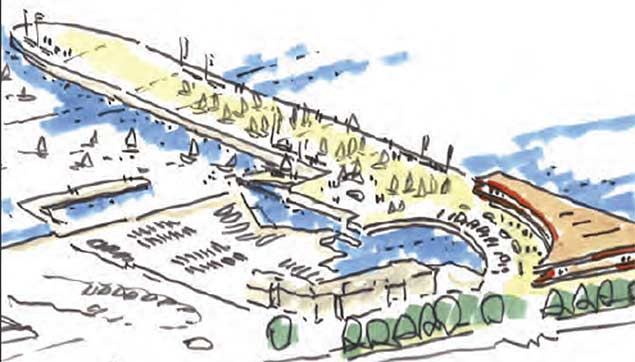 The proposed National Watersports Campus and Municipal Sailing Centre will bring the Carlisle Pier back to life
The proposed National Watersports Campus and Municipal Sailing Centre will bring the Carlisle Pier back to life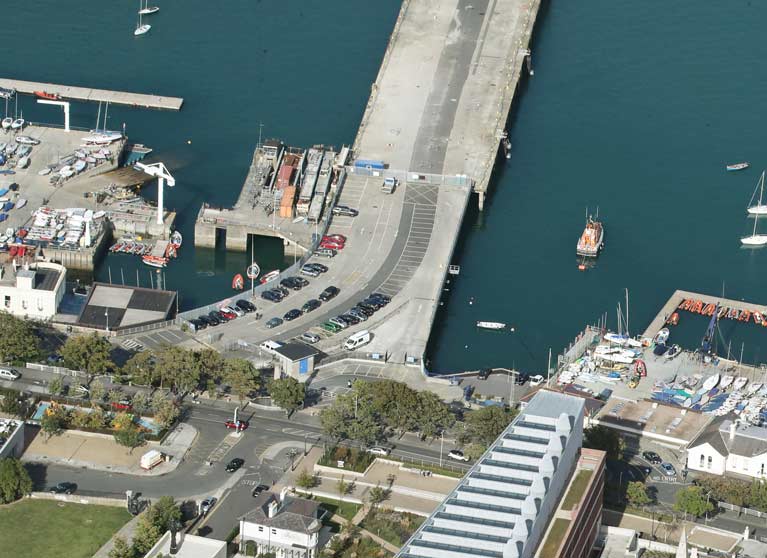 The location of the proposed Municipal Sailing Centre and National Watersports Campus is at the head of the Carlisle Pier between the Royal St George YC and the National YC
The location of the proposed Municipal Sailing Centre and National Watersports Campus is at the head of the Carlisle Pier between the Royal St George YC and the National YC
Clearly the loss of the car-parking currently provided for want of anything better to do with Carlisle Pier is going to be something of a problem. But it should be said that car-parking is something which deserves much more attention nationally and internationally than it currently receives. They should have university departments specializing in it, for it affects most of us, and taking the easiest options of open space parking now means, for instance, that the USA has enough designated car-parks to cover the entire state of Connecticut. This may seem only tangential to the problems of Dun Laoghaire, but already elsewhere in the harbour the soft option of “making it a car park” has been too readily used.
Anyway, with the new National Watersports Campus brought into being on Carlisle Pier, we move next to St Michaels Wharf and the vast expanses of the former ferryport. It cries out for a built development. If they could only sort out whether or not its very existence is legal in the first place, there’s still enormous potential in the option of developing some of the Terminal Buildings as a growing tech hub, but equally I don’t see why it shouldn’t be seen in terms of residential development.
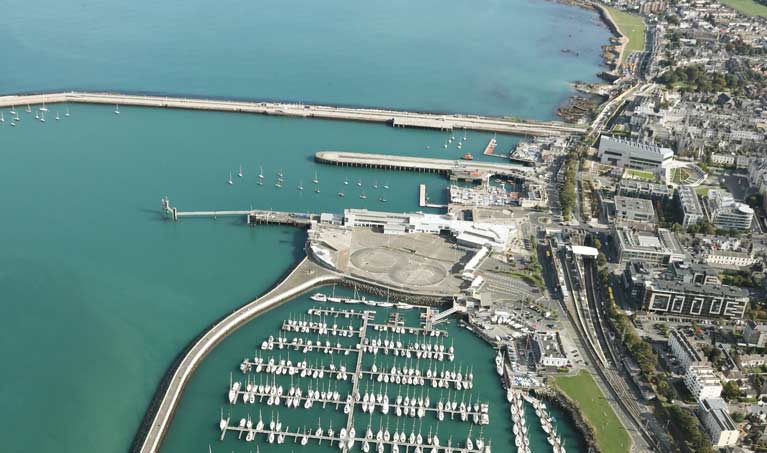 An area of enormous potential. By developing all of the St Michael’s Wharf space for residential use and as a tech hub, a significant part of Dun Laoghaire town would in effect be moved into the middle of the harbour, thereby strengthening the links between the two. Photo: Barrow Coakley/Simon Coate
An area of enormous potential. By developing all of the St Michael’s Wharf space for residential use and as a tech hub, a significant part of Dun Laoghaire town would in effect be moved into the middle of the harbour, thereby strengthening the links between the two. Photo: Barrow Coakley/Simon Coate
It wouldn’t be the kind of place where you could comfortably raise a typical Irish family, but it would be ideal for more senior residents who enjoy being beside the sea and in the midst of living activity, yet can no longer be an active part of all of it.
David McWilliam rightly makes the point that developing Dun Laoghaire properly will lead to an interface between the public and private sector, but frankly if the St Michael’s Wharf spaces are going to be attractively developed for some residential use, it will need the inspired input of the private sector, though perhaps under reasonably strict controls.
By making St Michael’s Wharf partly residential, we strengthen the links between town and harbour by literally creating a new part of the town into the middle of the harbour. You would be surprised by how well such new developments can work.
But in taking an overview of possible re-development of the Dun Laoghaire waterfront’s under-utilised spaces, we should remember that one of the shop-keepers to whom Jennifer O’Connell talked spoke of the need to make Dun Laoghaire a tourist magnet “like Howth”.
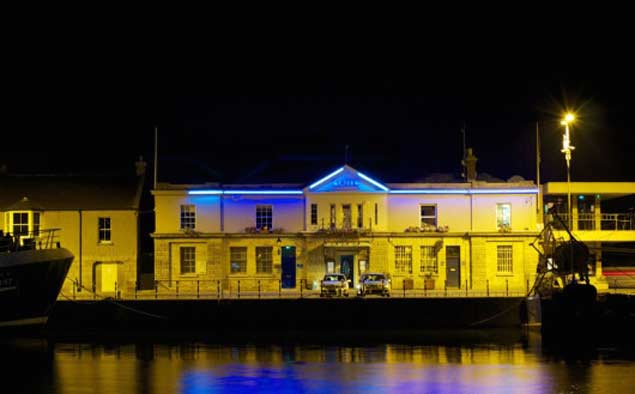 Just three of the unplanned mix of buildings on the West Pier in Howth include (left to right) the former Customs House (it may be needed again with Brexit), the Harbour Masters Office, and Aqua Restaurant in the former Howth Yacht Club building
Just three of the unplanned mix of buildings on the West Pier in Howth include (left to right) the former Customs House (it may be needed again with Brexit), the Harbour Masters Office, and Aqua Restaurant in the former Howth Yacht Club building
You should be careful what you wish for, Madam. Howth is sometimes over-run. Nevertheless, all the Dun Laoghaire waterfront developments we’ve referred to thus far will be carefully-planned and inevitably modern-looking buildings. In contrast, the quaint charm of Howth’s West Pier with its many restaurants, fish shop and whatever is that it was not planned in any way at all. In fact, once the modern harbour had emerged in its current shape in the mid-1980s, the OPW – the Office of Public Works - saw itself still as the OPW, but this time it was as the Office of Public Wrecking.
They wanted to knock every bockety little building along the West Pier in order to create more room for fish lorries and other industrial traffic, and the plan was to move any still existing highly-individualistic little businesses into a nearby and ever so modern Business Park.
Fortunately, official inertia and probably a convenient national financial crisis prevented anything further happening in the destruction department, and after the empty buildings had remained so for some time, private enterprise finally got its way and took them over for the present cheerful visitor-attracting selection of retail outlets of all kinds.
It all happened by happy accident. But you can’t plan happy accidents. Nevertheless I would suggest that as the east end pf the Dun Laoghaire Harbour waterfront right along as far westward as the Irish Lights premises is going to be under a formalized look, as a bit of welcome contrast we should take a radical overview of the entire Inner Harbour – the Coal Harbour area if you prefer – to see how it could be allowed to become a characterful Dun Laoghaire version of the vieux port which you’ll find in any half decent French harbour of character.
There’s far more space down towards the Coal Harbour than you’d think – it only seems limited because that great big ramp road down to Trader’s Wharf or whatever it’s called cuts the area in two. Immediately east of the ramp, there’s the old coastguard station, which is surely ripe for multiple craft and character uses and could be the centre of a new/old harbourside village if only that big ramp thing could be done away with altogether, for there are already two other ways of accessing the inner harbour.
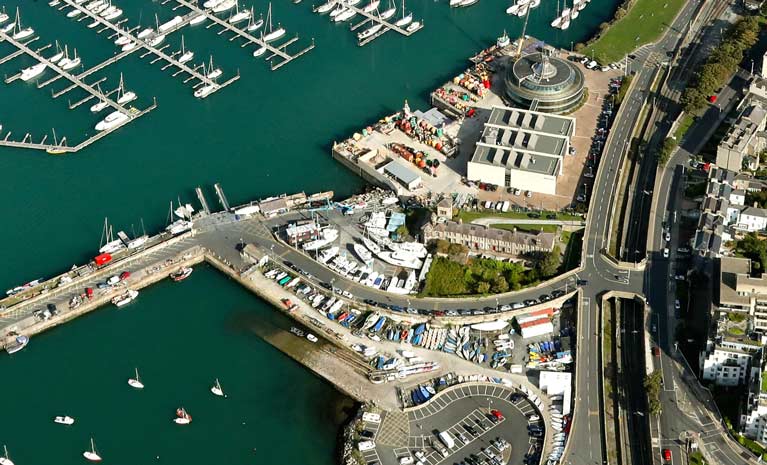 The hidden site with potential for the Old Dunleary Harbour Village. At present divided by the large ramp road - half of which is used for parking - the area between Irish Lights and the Coal Harbour includes the old Coastguard Station which could be the central focus for a characterful small-scale development. Photo: Barrow Coakley/Simon Coate
The hidden site with potential for the Old Dunleary Harbour Village. At present divided by the large ramp road - half of which is used for parking - the area between Irish Lights and the Coal Harbour includes the old Coastguard Station which could be the central focus for a characterful small-scale development. Photo: Barrow Coakley/Simon Coate
The potential is enormous. But in the first instance, Dun Laoghaire town has to get its act together regarding the changeover from retail to residential, for the narrow streets in the heart of the old town are really only capable of supporting about a third of the shop premises – many already boarded up – which give the place such a sad air.
So the “old town” becomes much more residential, but with a growth in the proportion of service-providing retail outlets, while new life is given to the waterfront with the National Watersports Campus on the Carlisle Pier and an impressive residential and tech hub on the St Michael’s Wharf site.
Along to the west we’ll have the new yet characterful Old Dunleary Harbour Village gathered around the old Coastguard Building, a place with a variety of eating places including some so new and trendy that they’ll be discovered for the rest of the world by the Restaurant Critic of The Irish Times, and so the Paper of Record can make friends again with people who actually live and work in the Dun Laoghaire waterfront area.
Irish Times Asks: How Do We Solve A Problem Like Dun Laoghaire?
“If Dun Laoghaire can’t thrive in a period of economic recovery, the feeling seems to be, what hope is there for everywhere else?
“What chance have towns less blessed with abundant natural amenities, an affluent population, proximity to the capital, a large harbour and the sea?”
That’s the question posed in Jennifer O’Connell’s exploration for The Irish Times today (Saturday 31 August) of Dun Laoghaire and its issues with reviving a town centre in decline, and generating revenue from a port where maintenance costs will only rise.
With the harbour’s new custodians, Dun Laoghaire-Rathdown County Council, seeking strategic advice for a new economic plan, local politicians and business interests have differing views as to what it could achieve.
That’s based on the lack of progress in many other proposals in recent years, from visions of an urban beach to a floating hotel and a new digital hub — while a major cruise liner berth was the latest idea to be abandoned.
The Irish Times has much more on the story HERE.
Dun Laoghaire Lifeboat Launches To Yacht Dismasted Off Dalkey Island
Dun Laoghaire RNLI launched to a 34ft yacht unexpectedly dismasted while sailing near Dalkey Island yesterday afternoon (Sunday 25 August).
The skipper aboard the yacht was able to call the coastguard by VHF radio, and the volunteer lifeboat crew were requested to launch the all-weather Anna Livia at 2.15pm in calm conditions, Dun Laoghaire RNLI reports.
Once on the scene, the lifeboat crew checked that the skipper was safe and uninjured, then he and his yacht were towed back to Dun Laoghaire.
Speaking after the callout, Dun Laoghaire RNLI’s coxswain Mark McGibney said: “In this situation where the yacht unexpectedly dismasted, the skipper was able to alert the coastguard as thankfully he had a backup handheld VHF radio. It is also essential to always carry a means of communication.”
Hours before, Larne RNLI was requested to launch by Belfast coastguard to reports of a sinking vessel with two people on board.
Launching both of their lifeboats, Larne RNLI’s volunteer crew made their way towards the casualty vessel’s reported position, just outside of Larne Harbour.
While en route, the inshore lifeboat Terry was stopped by a passing pleasure craft which reported they had recovered the two people from the casualty vessel, who were found to be safe and well and were returned to shore on the all-weather lifeboat.
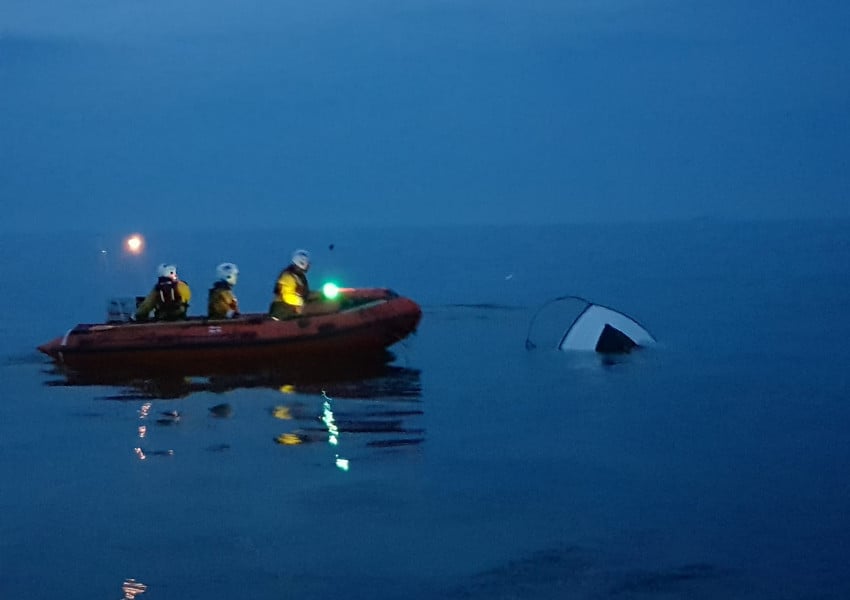
Later both lifeboats were requested to survey the casualty vessel to see if anything could be salvaged — but by then it was mostly submerged, as Larne RNLI reports.
Earlier in this Bank Holiday weekend for Northern Ireland, Kilkeel RNLI launched late on Friday (23 August) to attend a 10m yacht with two on board which had become stranded with a rope in the propeller.
Kilkee RNLI says the volunteer crew located the yacht Villa Vilja — which was on passage from Tromso, Norway to the Caribbean — seven miles north-east of Kilkeel in freshening conditions.
And with the yacht tossing about in the rough seas, the lifeboat helm brought the lifeboat safely aside and a crew member boarded the yacht to check all was well to establish a tow.
Despite the challenging conditions, the yacht was brought safely into Kilkeel Harbour where the local coastguard team ensured it was safely and securely berthed at the pontoon.
Kilkeel RNLI lifeboat operations manager John Fisher said: “The transfer of a crew member to another vessel is a manoeuvre the crew often practice but with both boats being tossed about, the transfer was particularly difficult — but was managed, as usual, in a very safe professional manner and we wish the sailors a safe onward passage to the Caribbean.”
Dun Laoghaire Ready For IRONMAN 70.3 Triathlon This Weekend
Ireland’s biggest triathlon of 2019 comes to Dun Laoghaire this weekend as IRONMAN 70.3 Dun Laoghaire brings premier athletes from across the island and around the globe to Dublin Bay.
Sunday 25 August is the date for the three-part race that comprises a 2km swim from Sandycove around Scotsman’s Bay, a 90km cycle route that rounds the Wicklow Mountains via Roundwood, and a 21km run finishing at Dun Laoghaire Harbour.
Dun Laoghaire-Rathdown County Council has listed a number of temporary road closures throughout the town and surrounding areas over the weekend around the event.
Local access will be maintained where possible and diversions clearly signposted, the local authority says.
Dun Laoghaire Council Seeks Tenders On Strategy For Harbour & Town
Dun Laoghaire-Rathdown County Council is inviting tenders for expert economic and strategic advice for Dun Laoghaire Harbour, which came under its control late last year.
The request for tenders (RFT), which is open until Tuesday 17 September, says the local authority is “seeing expert advice on the development of the harbour for the benefit of its citizens”.
The move comes three months after the authority withdrew controversial plans for a €30 million berth for cruise liners in the harbour, as previously reported on Afloat.ie.
A separate RFT also seeks “expert economic, spatial and strategic advice” for Dun Laoghaire’s town centre adjacent to the harbour.
“In recent times, development in the town has been largely focused on increasing residential capacity with a consequential decrease in the amount of small-scale commercial office floor space available for employment uses locally and a reduction in the overall number of jobs located within the town,” the local authority says.
It adds that the Government’s Urban Regeneration and Development Fund “provided an opportunity for Dun Laoghaire-Rathdown County Council through a Category B application to carry out a study of the economic profile of the town, examine the changing nature of office-based development, make recommendations in relation to future potential economic opportunities and identify infrastructure deficits that exist in the town”.
Relevant documents for each RFT are available to download from the official links above (login required).
Busy Midweek Afternoon For Dun Laoghaire Coast Guard
A warm afternoon in Dublin Bay yesterday (Wednesday 24 July) also saw three callouts for Dun Laoghaire Coast Guard within the space of an hour.
The first at 5pm involved a Jeep-type vehicle spotted floating in the harbour. Satisfied that no one was in the vehicle, the officer in charge watched it sink rapidly before deploying two safety marks.
Fifteen minutes later, a call came from a mender of the public who spotted kayaks in difficulty at Dalkey Sound, with one casualty clinging to the side of a kayak.
Local pleasure craft assisted by a Pan Pan alert before Dun Laoghaire RNLI’s inshore lifeboat arrived on scene to escort the kayaking group to safety.
The Dun Laoghaire Coast Guard march team sighted the group trying to make passage to Coliemore Harbour and advised to alter course to Bulloch as they were fighting against the tide and wind and making poor progress.
A third callout at 6pm saw the team stood down en route to a person in difficulty due to the tide at Merrion Strand after they made it ashore safely.
A man found clinging to his capsized boat off Dalkey yesterday afternoon (Monday 15 July) was rescued by Dun Laoghaire’s RNLI lifeboat.
The volunteer lifeboat crew were requested by the Irish Coast Guard to launch their inshore lifeboat at 3.52pm following a report that a boat had capsized and a man was in the sea off Dalkey.
Several members of the public had reported seeing the man in difficulty and raised the alarm.
The lifeboat launched immediately and on arrival at the scene observed that a local fisherman was assisting the casualty by keeping him afloat from his 5.5m boat with the aid of a boat hook.
The crew proceeded to take the man out of the water and assess his condition before administering casualty care.
The coastguard helicopter Rescue 116 from Dublin was also tasked and met the lifeboat crew at Coliemore Harbour in Dalkey, where the man was given more casualty care.
A local doctor was also present at the scene and assisted the casualty until the ambulance arrived minutes later. He was subsequently transferred to St Vincent’s Hospital for further treatment.
Commenting after the callout, Dun Laoghaire RNLI helm Gary Hayes said: “This was a tremendous effort from all involved. We would like to extend our praise to the members of the public who alerted the emergency services as quickly as they did.
“We also want to thank the local fisherman for his help in this rescue and for his efforts to saving a life.”
Locals and visitors will have a change to celebrate the lifesaving work of Dun Laoghaire’s RNLI volunteers at the lifeboat station’s open day from 1pm this Sunday 21 July.
The station at Carlisle Pier will host tours of the all-weather lifeboat Anna Livia, while the inshore lifeboat Realt Na Mara will be on display at the old boathouse beside Rogan’s Slipway on the East Pier.
Souvenirs in support of the charitable work of the RNLI will be on sale in the station shop throughout the afternoon.
And special guests will be visiting the RNLI station during the afternoon, including Stormy Sam and the Dalkey Ukulele Klub.
Stephen Wynne, Dun Laoghaire RNLI lifeboat operations manager, said: “We are delighted to welcome everyone to inspect the lifeboats and meet the volunteer crew members and get an insight to what they do!”
The Volvo Dun Laoghaire Regatta has something for everyone at all levels of sailing writes W M Nixon. It’s an event which attracts sailors who have reached the highest levels of international competition ranging through Olympic Medalists and America’s Cup contenders to those who have proven themselves at the very sharpest sharp end of offshore racing.
Yet equally it is the ultimate suburban sailfest for 480 boats (now 500, see here - ed) and their many crews in numerous classes, bringing out the competitive spirit in amiable club sailors who may be competing on Dublin Bay within sight of their home neighbourhood, yet out on the waters of this very special bit of the sea, they become so absorbed in the racing of the day that they could be at some purpose-built venue some hundreds of miles from home.
Regattas are as much about people as boats, and the upcoming VDLR 2019 (it begins next Thursday) has certainly drawn in some noted sailors of extra interest. For instance, Eddie Warden-Owen, the CEO of the Royal Ocean Racing Club, may be best known for his central administrative role in the global offshore racing scene, and before that perhaps his greatest international achievement was in the campaigns whereby he was the guiding light in raising major Italian international campaigns to the highest level.
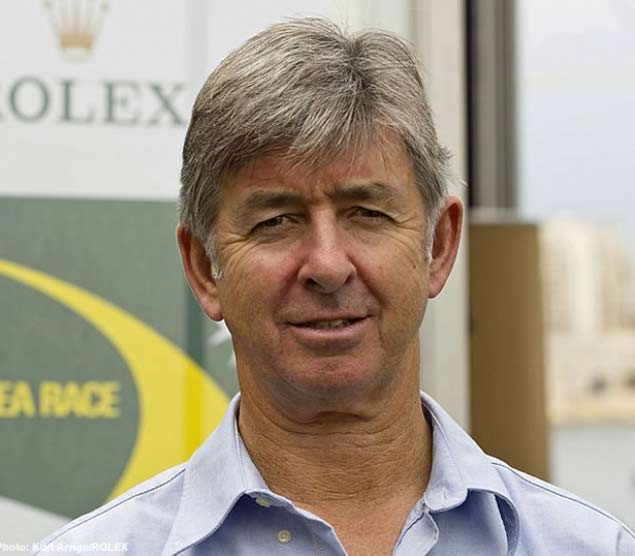 The RORC’s CEO Eddie Warden-Owen will be taking part in the Volvo Dun Laoghaire Regatta 2019 in a strictly private capacity – as co-skipper of the 121-year-old Seabird Half Rater Scoter from Treardur Bay SC in Anglesey.
The RORC’s CEO Eddie Warden-Owen will be taking part in the Volvo Dun Laoghaire Regatta 2019 in a strictly private capacity – as co-skipper of the 121-year-old Seabird Half Rater Scoter from Treardur Bay SC in Anglesey.
Yet the RORC’s top administrative honcho has a family home club like many other sailors, and in the case of the Warden-Owen, it is Treardur Bay SC on the Anglesey coast in North Wales. So though the young Warden-Owen may first have emerged at national level as a GP 14 sailor of note, his family’s primary loyalty in Treardur Bay is to the 1898-founded Seabird Class of Half Raters, 20-foot semi-keelboat with centreboards which continue to provide close racing and the right class spirit at Treardur Bay and other centres.
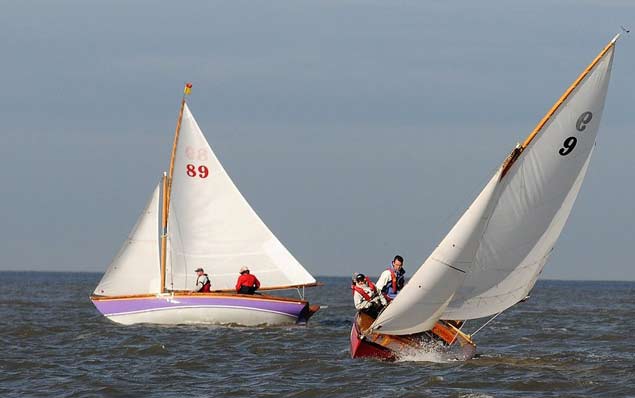 The Seabird Half Raters had their first race on June 8th 1899
The Seabird Half Raters had their first race on June 8th 1899
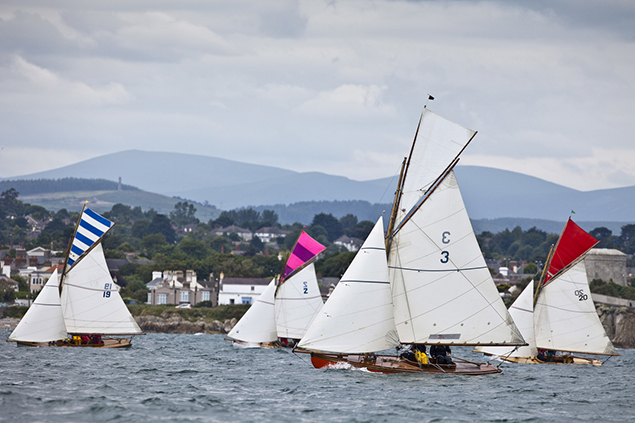 The Howth 17s, seen here in a previous VDLR, had their first race on May 4th 1898. Photo: VDLR
The Howth 17s, seen here in a previous VDLR, had their first race on May 4th 1898. Photo: VDLR
North Wales has several such classes, and in recent years with improved road trailerage, they have taken the ferry to Dublin to add their own lively input to Dun Laoghaire Regatta. This time round it’s the turn of Treardur Bay to be the honoured visitors, with its members coming across with their Seabirds and also their 14ft Myth dinghy class.
The Myths are from the time of the club’s foundation around 1920, but the Seabirds go back even further, to Merseyside in 1898-99, and Eddie Warden-Owen and his brother David are custodians of the oldest boat in the visiting flotilla, the 121-year-old Scoter. Thus they will thus be vying for seniority with another classic group taking part at Dun Laoghaire, the Howth 17s from north of the bay whose design and debut afloat pre-dated the advent of the Seabirds by barely a year.
Not all the noted visiting sailors will be in unlikely alliance with boats of ancient vintage, though admittedly the RS Elite keelboats, with their design throwback to the special America’s Cup keelboats of a previous era, may still seem as modern as tomorrow to most Dublin Bay sailors.
In sailing terms, Dublin Bay is one of the most settled communities on the planet. When Dublin Bay sailors find a One Design they like, they tend to stay with it for decades, with years after year of congenial and convenient local sport in a friendly environment in the same boats, a process which is likely to be reinforced by the unexpected longevity of glassfibre craft.
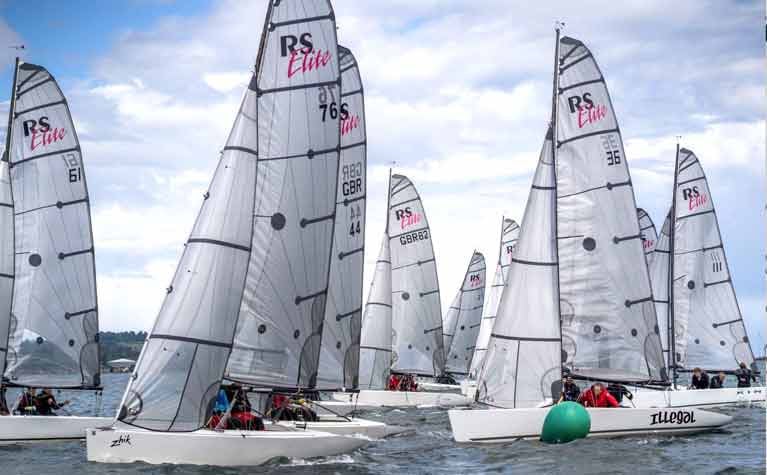 The appearance of the RS Elite is something of an acquired taste……
The appearance of the RS Elite is something of an acquired taste……
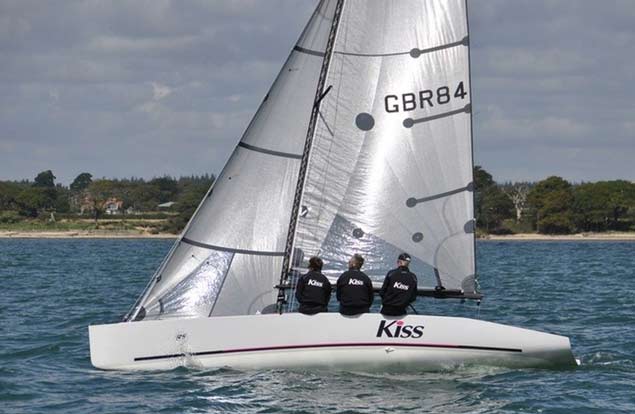 …..but they look better when properly trimmed and going well
…..but they look better when properly trimmed and going well
So the fact that the RS Elites have chosen the VDLR 2019 to incorporate their annual National Championship is a compliment to their hosts and the spirit of the bay, and the class in turn is giving it full top-level support with its contenders including at least two former Olympic medallists – current RS Elite Champion Mike McIntyre who took Gold in the Star Class in 1988, and Ossie Stewart who got bronze in the 1992 Olympiad crewing with Lawrie Smith in the Soling, while for good measure the 34-strong RS Elite lineup also includes current International 14 World Champion Andy Partington and former International Dragon Edinburgh Cup winner Simon Brien from Cultra on Belfast Lough.
 Current RS Elite Champion is Mike McIntyre, Gold Medallist in the Star Class in the 1988 Olympics
Current RS Elite Champion is Mike McIntyre, Gold Medallist in the Star Class in the 1988 Olympics
Our own Olympic Silver Medallist Annalise Murphy is also down for racing in Dun Laoghaire with her International Moth if she can balance it with the current 49erFX campaigning. But once in Dun Laoghaire, the mood can be so relaxing that mid-regatta boat transferences are not unknown, and we might just as likely see our top sailor out on the bay with her mother Cathy McAleavey in one of the latter’s Dublin Bay Water Wags, truly a “Classic of the Classics” with the class’s origins going all the way back to 1887.
This friendly inter-change between varying classes and extremely different boat types hints at something very special in the total sailing environment to be found in the Greater Dublin area, and for locals the VDLR serves a very useful extra purpose in reminding us of just how remarkable is our local sailing.
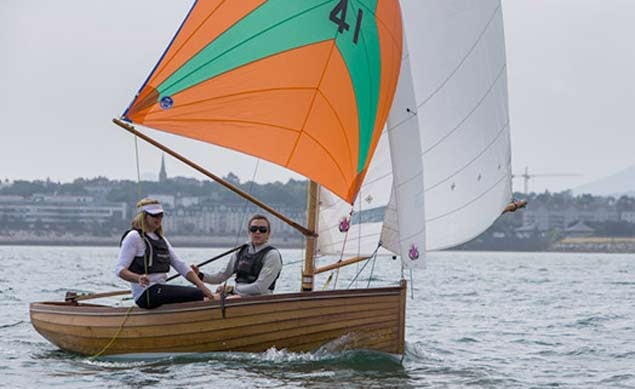 Cathy McAleavy racing her Water Wag in the VDLR with her daughter, Olympic Medallist Annalise Murphy. Photo: VDLR
Cathy McAleavy racing her Water Wag in the VDLR with her daughter, Olympic Medallist Annalise Murphy. Photo: VDLR
We have a handsome and vibrant river city, elegantly set in surrounding hills and mountains, and dynamically interacting with a graceful bay. It’s a bay that gives a sense of immediate access to open sea while at the same time providing sufficient sheltered water to promise the ideal location for close-fought racing among a large fleet of boats of many types, with competition at all levels of intensity.
Greater Dublin’s busy population well knows how to make the best use of the diverse sailing opportunities on its doorstep. And for its notably affluent population in the conurbation’s extensive hill-girt southern sector, virtually all of the remarkable maritime energy is focused through one sailing port, the large and classically-inspired artificial harbour of Dun Laoghaire with its four highly-individualistic and undoubtedly stylish yacht clubs, whose historic style is balanced by the most convenient of quayside facilities supported by an extensive marina.
So many factors combine in making the Volvo Dun Laoghaire Regatta the largest sailing event in Ireland that in the end whether it’s a success or an outstanding success comes down to the one element over which the organisers have no control: the weather.
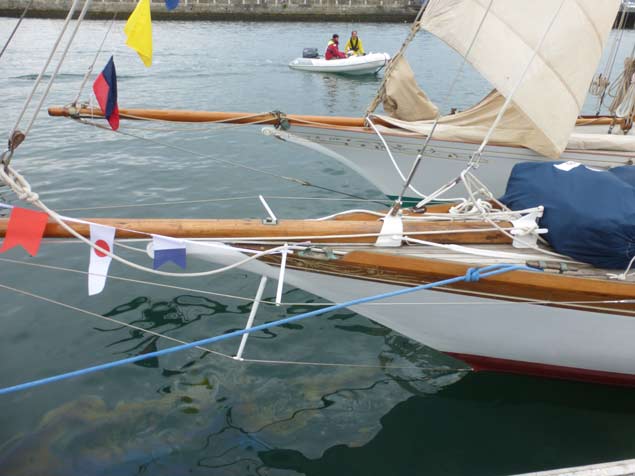 Gentle summer weather, vintage clipper bows – the distinctive stem profiles of Myfanwy (built 1897) and Peggy Bawn (built 1894) at the VDLR 2017. Photo: W M Nixon
Gentle summer weather, vintage clipper bows – the distinctive stem profiles of Myfanwy (built 1897) and Peggy Bawn (built 1894) at the VDLR 2017. Photo: W M Nixon
Last time round in 2017, summer was settled comfortably on Dun Laoghaire, with balmy almost windless evenings, yet each day brought more than enough wind to see the programme satisfactorily completed, while keeping things gentle enough such that many classes – particularly those in the classics and traditional divisions - could finish with considerable style within the harbour.
But then, 2017 marked the Bicentenary of this remarkable structure, which has been so solidly built of local granite that it now seems to be a natural part of the landscape. Nevertheless the memories and sentiments of the Bicentenary have been incorporated into the way we think about this very special regatta with its unique purpose-designed format, which only finally emerged in 2005 after several attempts over several decades to provide Dun Laoghaire with a flagship event which matched the significance of the Harbour’s role in local, national and international sailing.
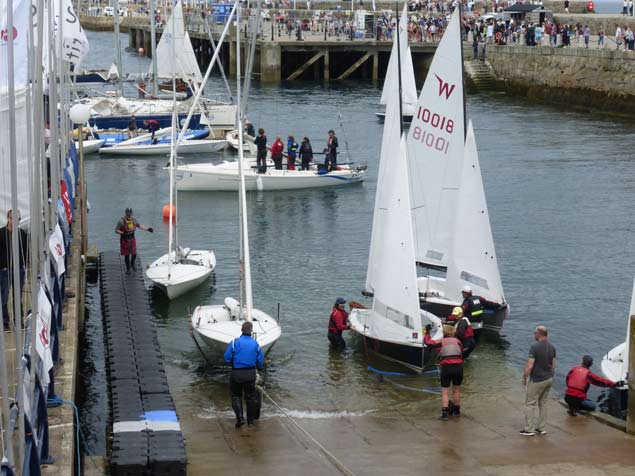 A 200-year-old harbour responds to contemporary needs – retrieval time for Flying Fifteens and Wayfarers at the National YC during the VDLR 2017. Photo: W M Nixon
A 200-year-old harbour responds to contemporary needs – retrieval time for Flying Fifteens and Wayfarers at the National YC during the VDLR 2017. Photo: W M Nixon
But while the basic programme of four days of racing beginning on Thursday afternoon and concluding with a boisterous prize-giving on the Sunday afternoon has been successfully maintained, each time round the Organising Committee incorporates lessons learned from each staging. And they add useful innovations too, for the Dublin Bay sailing setup is such that Don O’Dowd, the current Chairman, and his Organising Committee find like their predecessors that their “clients” are so passionate about the sport in their bay that they are definitely not backwards in coming forward with suggestions for their own notions of regatta improvement.
 Don O’Dowd, Regatta Chairman
Don O’Dowd, Regatta Chairman
All in all, it’s an extraordinary logistical challenge, with 450 boats and at least 24 separate classes, with the actual number depending on how you define “class”. There’s everything from top-level IRC racers through a colourful variety of One Designs and on to traditional and classic boats of such vintage that it’s a brave pundit who would say just how old they are.
As for the actual sailing, it can vary from a crowded daily programme with top-standard races back-to-back, through just one gentle race for special boats, while the IRC fleet have the added option of joining a division with just one coastal race per day which better allows them to spread their wings, and for 2019’s Regatta, the coastal racers will include George Sisk’s Xp44 WOW (RIYC) fresh from victory in the coastal division at the Sovereign’s Cup in Kinsale, Dingle race winner Paul O’Higgins’ JPK 1080 Rockabill VI, former Sailor of the Year Conor Fogerty’s new foiling Benetau Figaro 3 Raw from Howth on the countdown to the Fastnet Race on August 3rd, and current ISORA Champion, the J/109 Mojito (Peter Dunlop & Vicky Cox, Pwllheli SC).
This means that Mojito will not be in face-to-face competition with the increasing Irish J/109 fleet, which reached a fresh height of competitiveness at the Sovereign’s, with the new boys on the block for 2019, Richard Colwell and Johnny Murphy’s Outrajeous, looking good for honours with Mark Mansfield – who was on the strength in the successful campaign in Kinsale – back on board for the Battle in the Bay.
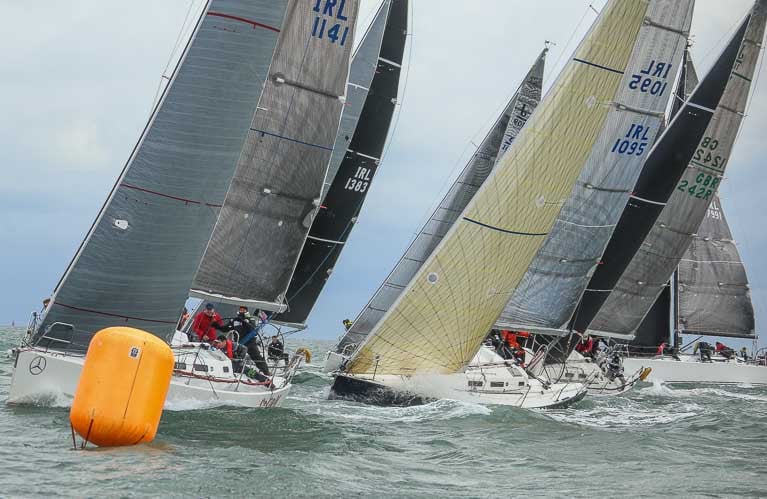 J/109s in close contention in Dublin Bay. This classic American design fits well with the Dublin Bay One Design tradition. Photo: Afloat.ie
J/109s in close contention in Dublin Bay. This classic American design fits well with the Dublin Bay One Design tradition. Photo: Afloat.ie
Not all the top J/109s were at Kinsale, and current 2019 Champion, the Goodbody family’s White Mischief (RIYC), is hotly tipped for success sailing on waters in which pater familias Tim Goodbody has achieved more major wins than anyone can remember in several different types of very competitive One Designs. Meanwhile, a former Irish champion J/109, Pat Kelly’s Storm of Howth and Rush SC, has beefed up her crew strength for Dun Laoghaire with the addition of sailmaker Nigel Young.
The J/109s in their current hyper-tuned state are more than enough for most of us to be contemplating, but a further ingredient is added to the mix with the presence of the newly re-crowned RC35 champion, the First 36.7 Animal from Scotland (Debbie Aitken), so for those with a mind to concentrate on the results of just one class, the J/109s have enough to be going on with.
But to take such an approach is not in the spirit of the regatta, and the reality is that if we go down the IRC Divisions, we happen upon the classic Half Tonners, miracles of restoration mostly based in Howth which in 2019’s hugely intense early season raised their racing bar even higher.
Currently, the pacesetter is Mata (Michael & Darren Wright and Rik De Neve, HYC), which a year ago was a somewhat tired old warrior which seemed to have her best years behind her. But the Wright team took her over and with crew boss Sam O’Byrne co-ordinating a meticulous re-birth in Alan Power’s renowned “laboratory” in Malahide, Mata was ready for the Scottish Series at the end of May where she gave her first indication of things to come as runner-up to clubmate Jonny Swann’s Harmony. Then she was in the groove in the ICRA Nationals to win, and by the time the Half Tonners were joined in really serious group battle at Kinsale, it was Mata which won the Half-Ton Nationals incorporated in the series, and for Dun Laoghaire, her crew-of-all-the-talents continues to include sailmaker Shane Hughes.
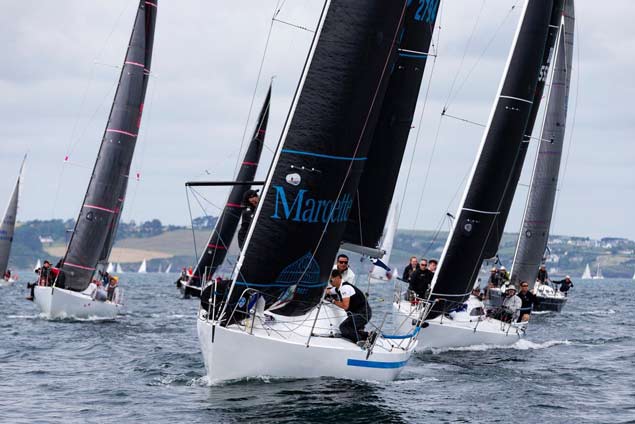 The Half Tonner Mata winning in Kinsale. Only a year ago, she was a tired old warhorse, but a major revival programme has worked wonders
The Half Tonner Mata winning in Kinsale. Only a year ago, she was a tired old warhorse, but a major revival programme has worked wonders
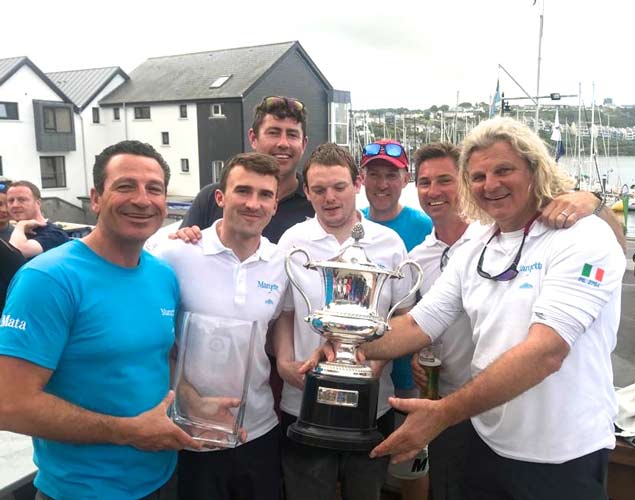 These are the boys to beat – the Mata crew in Kinsale with the Irish Half-Ton Champions trophy are (left to right) Darren Wright (helm), Sam O’Byrne (mainsheet), Killian Collins (tactics), Ciaran White, Shane Hughes of North Sails, Rick De Neve, and Michael Wright
These are the boys to beat – the Mata crew in Kinsale with the Irish Half-Ton Champions trophy are (left to right) Darren Wright (helm), Sam O’Byrne (mainsheet), Killian Collins (tactics), Ciaran White, Shane Hughes of North Sails, Rick De Neve, and Michael Wright
Inevitably the location of the sailmaking sorcerers throughout the fleet is always a useful guide to potential performance, and up in the dizzy heights of Class 0, the word is that Maurice Prof O’Connell will be back with Crosshaven’s Conor Phelan on the Ker 36 Jump Juice to see if they can topple Frank Whelan of Greystones from the remarkable dominance he showed in Kinsale to win the Sovereign’s Cup with a clean sweep of wins right down the line with the Grand Soleil 44 Eleuthera.
Another element in Class 0 is the regular and competitive presence of Jay Colville’s First 40 Forty Licks from East Down YC in Strangford Lough, while there’s a new presence to be factored in with the re-appearance of Jamie McWilliam of the Royal Hong Kong YC with his Ker Fast Forty Signal 8, and the turnout in Class 0 has another twist with the appearance of Scotland’s Jonathan Anderson with the J/122 El Gran Senor.
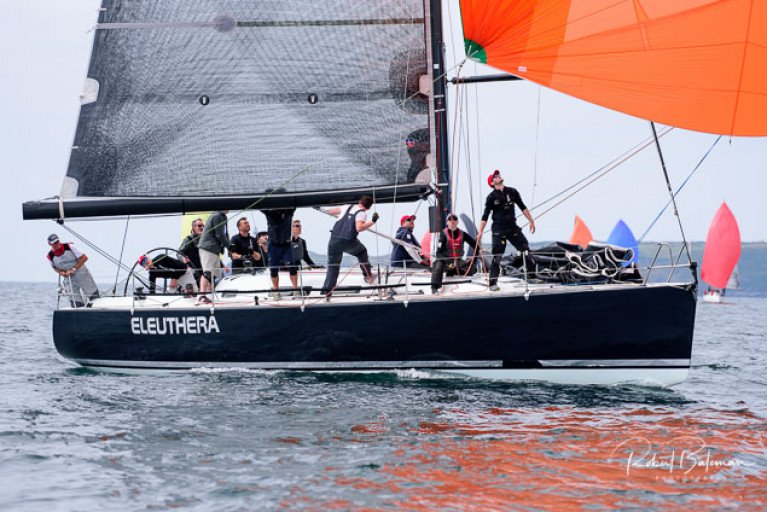 Another of the “Boats to Beat” – Frank Whelan’s Eleuthera from Greystones will arrive in Dublin Bay fresh from a clean sweep in Kinsale. Photo: Robert Bateman
Another of the “Boats to Beat” – Frank Whelan’s Eleuthera from Greystones will arrive in Dublin Bay fresh from a clean sweep in Kinsale. Photo: Robert Bateman
After considering the various rating permutations which come as part of the deal with IRC classes, it’s like a breath of fresh air to turn to the extensive One Design dinghy and keelboat presence, but even here the twenty or so classes which will be receiving their own starting signal present a bewildering variety of types, though one thing is clear – the visit of the RS Elites means that with 34 boats, they’re the most numerous keelboat OD class, toppling the Flying Fifteens with their 23 boats for 2019 from their usual dominant position, while it has to be said that the Sigma 33s, celebrating their 40th Anniversary, are putting in an excellent show with 20 boats all determined to make life difficult for current champion Rupert (Dick & Philip Lovegrove, RStGYC).
Another good turnout is the 15 boats being achieved by the J/80 Class, which has proven to be particularly suited to Irish requirements. The impact of the J/80 may be relatively new, but we cannot help but notice that one of the favoured helms in the class next week has to be Robert Dix, yet another product of the remarkable sailing nursery which is Malahide.
His continuing sailing skill prompts us to remind the Royal Cork YC that at their Quarter Millenial Celebrations in 1970, one Robert Dix at age 17 emerged as the youngest-ever winner of the Helmsman’s Championship of Ireland. With the RCYC Tricentenary coming up next year, the Golden Jubilee of Dixie’s success is surely something which will get a special mention.
With many of the One Designs - dinghies and keelboats alike - it’s national and world championships coming down the line which are shaping their thinking. The Flying Fifteens are well into the countdown for their 2019 Worlds at the National YC in September, while the GP14 Worlds are in Skerries next year, and they have their Irish nationals at that venue next month. Meanwhile, the VDLR 2019 is also their Leinster Championship, and a fleet of 34 makes them the biggest dinghy class, notable among them being new GP 14 sailor Alex Barry of Monkstown Bay on Cork Harbour, whose early successes this year point towards an interesting trajectory towards the Worlds.
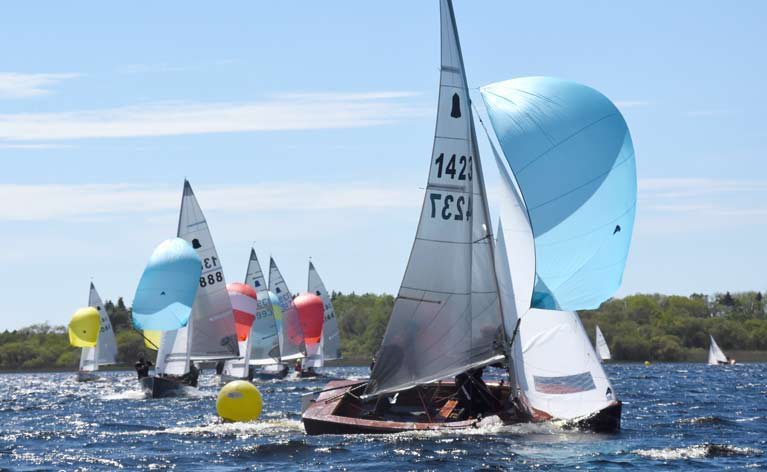 The GP 14 Munsters at Cullaun in May, when Alex Barry of Monkstown Bay and Richard Leonard made a successful debut with the class. They will be racing with a large class of GP 14s in the VDLR 2019 in what will also be the Leinster Championship. Photo: Rachel Thunder
The GP 14 Munsters at Cullaun in May, when Alex Barry of Monkstown Bay and Richard Leonard made a successful debut with the class. They will be racing with a large class of GP 14s in the VDLR 2019 in what will also be the Leinster Championship. Photo: Rachel Thunder
The introduction of a Classics & Traditional Division in the VDLR 2017 as a special for the Harbour Bicentenary worked so well two years ago that it’s a feature which has been retained, and of course if we add in the older One Designs which consider themselves race boats first and classics as a bonus, boats like the Seabirds, the Howth 17s, the Water Wags, the Mermaids and the Myths, there is actually a quite substantial Classics Regatta to be discerned within the larger picture.
There’s a substantial and varied entry in place. The huge numbers of volunteers are quietly working themselves into their vital roles. The flotilla of committee boats have been vigilantly checked for smooth functioning. And the structures – administrative and physical alike – are taking their final shape ashore. So now, with summer having firmly shown itself to be here or hereabouts – albeit somewhat unevenly - in recent weeks, what are the wind and weather prospects?
As the man said, forecasting is so difficult because it involves predicting the future…..We’re supposed to have access to reliable ten day forecasts these days, but 2019 has already shown that this is a mistaken assumption. At the time of writing, the Jetstream is to the north of us. Let us hope it stays there, yet leaves enough energy to provide a decent sailing breeze each day, but not too much…..
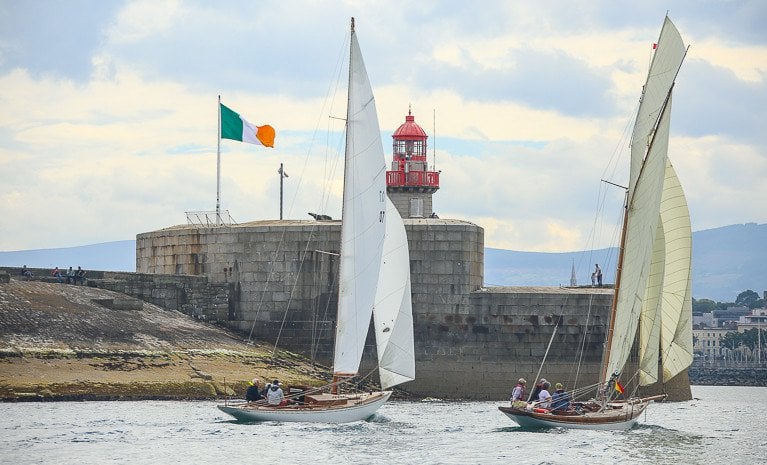 The enduring image of the Volvo Dun Laoghaire Regatta 2017 – in a warm summer breeze, the Dublin Bay 24 Periwinkle and the 1897 Alexander Richardson cutter Myfanwy race neck and neck for their in-harbour finish. Photo: Afloat.ie/David O’Brien
The enduring image of the Volvo Dun Laoghaire Regatta 2017 – in a warm summer breeze, the Dublin Bay 24 Periwinkle and the 1897 Alexander Richardson cutter Myfanwy race neck and neck for their in-harbour finish. Photo: Afloat.ie/David O’Brien
St Michael’s Rowing Club Dun Laoghaire Hosts Home Skiff Regatta On June Bank Holiday Weekend
This June Bank Holiday weekend, St Michael’s Rowing Club Dun Laoghaire hosted their home regatta, which brought together rowers from the East Coast rowing clubs: Arklow, Greystones, Bray, Dalkey, Wicklow, Fingal, and Stella Maris and St Patrick’s in Dublin.
The first of the 18 races kicked off at 9am with a gold medal win for St Michael’s senior ladies rowing in the Gráinne Mhaol, a boat built by Louis Hunkin of WC Hunkin and Sons, who was a special guest.
The event, which saw 90 crews compete in traditional Irish wooden skiffs, was held at Surfers’ Wharf at Seapoint Beach.
 Winning senior ladies Amy Smith, Enya Murray, Liz O’Toole and Nicola Fitzgerald with race sponsor Paul Morton of Morton Coaches | Photo: Mark Rust Fennell
Winning senior ladies Amy Smith, Enya Murray, Liz O’Toole and Nicola Fitzgerald with race sponsor Paul Morton of Morton Coaches | Photo: Mark Rust Fennell
“We selected this area and designed this particular race course in order to ensure that all races can be held within the fairly restrictive window of opportunity imposed by the tidal change, which is approximately five hours,” said Colm Crilly, St Michael’s committee member in charge of race course logistics.
“We are grateful that all clubs have proven very efficient with crew changeovers, as this allowed us to keep a tight schedule.”
Sonja Storm, safety logistics officer on the club committee, added: “An event like this, which brings together hundreds of participants, entails careful planning from the point of view of safety.
“This year, we were glad to welcome Robert Dunne, the designated safety officer of the East Coast Rowing Council, who oversaw this important aspect on the day.”
Jane Collins, organising co-supervisor said: “We would like to thank Dun Laoghaire-Rathdown County Council for their continued support and for allowing us to organise our home regatta every year in this location.”
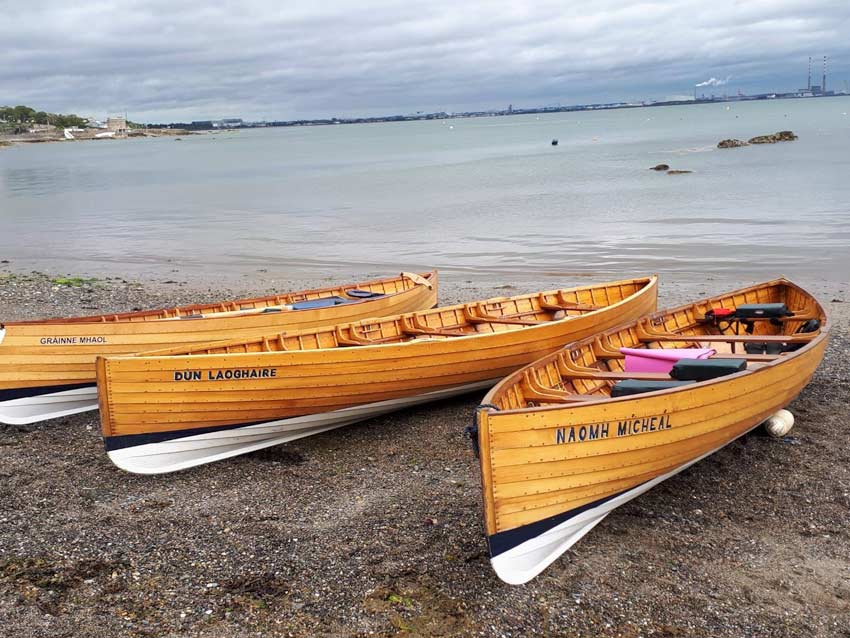 Skiffs on the beach at Surfers’ Wharf | Photo: Mark Rust Fennell
Skiffs on the beach at Surfers’ Wharf | Photo: Mark Rust Fennell
There were 10 adult races (Novice, Intermediate, Junior and Senior Ladies/Men; Mixed; and Vets) catering for a variety of abilities and experience.
Gary Byrne, St Michael’s club captain, said: “It is so encouraging to see a large number of people interested in coastal skiff rowing and racing, from people who just joined to well-seasoned rowers.”
Sarah Lovejoy, club youth officer, who oversaw youth rowing during the regatta said: “Rowing is an all-age sport with many physical and developmental benefits. You work as a team, and you have to tune in and pay attention to what your other team members are doing, because you have to be in sync.”
Rowers as young as 10 competed across a total of eight youth races, divided into four age groups.
The regatta was supported by a number of local businesses and sponsors. “This year, each race had an official sponsor, and we are so grateful for everyone who believes in us and supports us,” said Hilary Lovejoy, organising co-supervisor.
The next event St Michael’s Rowing Club will organise is their very own Hobbler’s Challenge, a 28km long race now open for registration.
“Our club is committed to continuing the tradition of skiff rowing that was passed on by local hobblers. Hosting our annual regatta and organising the Hobbler’s Challenge is a good way of ensuring that we promote this wonderful sport,” said James Tedd, club chairperson.
 Medals for the day’s winners | Photo: Mark Rust Fennell
Medals for the day’s winners | Photo: Mark Rust Fennell




























